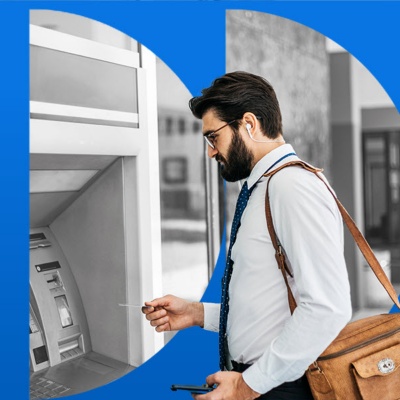Chris Bledsoe: When it comes to building innovative technology, partnership is one of the key ingredients to Workday's secret sauce. That's why we're partnering with companies like Amazon Web Services to revolutionize the enterprise management space by combining their cloud computing services with the Workday platform. In this episode of the Workday podcast, AWS's Bob Widlansky, principal AWS strategy and business development manager, and Christine Gabbard, the senior customer solutions manager, will delve into the power of this partnership and how it will benefit developers. I'm your host, Chris Bledsoe. Let's dive into the future of enterprise management technology. So before we get started, could you both please share a bit about your background and maybe your current roles there at AWS?
Christine Gabbard: So I'm the senior customer solutions manager supporting the Workday account for AWS. And what that role entails is it's technical and program management for the business to ensure Workday is successful with their AWS journey. I keep things moving. That's what I always tell Workday. Just let me know and I'll keep it moving. And I've been at AWS for three-and-a-half years, and my whole career I've been working in tech.
Bledsoe: Fantastic. How about you, Bob?
Bob Widlansky: All right. I work in our strategic business development group and focus on co-innovation initiatives with our strategic ISVs so a small set of customers that we work with on strategic initiatives, like Workday, and have been at AWS now for six years, both in business development and product management roles.
Bledsoe: But I know we've been working between Workday and AWS for a number of years. And what we're going to be talking about today is some of our latest innovations that we've done together. Perhaps you could share a little bit about the past and some of the things that we have been doing with AWS for a while.
Gabbard: Sure. I joined AWS three-and-a-half years ago, and I've been dedicated to the Workday account since then. And when I joined, Workday was already a well-established strategic account for us. And we've already had that relationship for many years. Back when Workday had at first announced moving to AWS,I think that was 2016. So, the thing about this relationship and this co-innovation is we've engaged closely with Workday, and we will continue to support Workday as you continue to innovate in the cloud. And Workday Extends, the product, runs on AWS today and recently launched in AWS Germany as well. So ,we're going to continue to build that strong partnership from and continue to focus on the joint go-to-market perspective in the US and EMEA and APJ. And another recent milestone that we just announced towards our go-to-market efforts was Workday is now available on the AWS Marketplace.
Bledsoe: Oh, that's fantastic.
Gabbard: Yeah, it's a pretty big deal for both companies. Yeah.
Widlansky: It is very much.
Bledsoe: So one of the things that's interesting too is I know we've had a multi-year relationship with AWS and Workday. And I'm kind of curious if you guys could share a little bit about what you know of relationship, what we've done, other initiatives. Cause this is just the most recent one we've worked on. So, I'm kind of curious if you could share a little bit about that?
Gabbard: We've been there through your journey to further innovate on the cloud. I know your company started in the cloud, but this is to further innovate on the AWS cloud. So we have a large team supporting your business to make sure that you can be successful on building the right platforms using certain tools. And now we are also starting to work with you for go-to-market motions, for example, the one we're going to talk about today. So that was probably back in 2015, I think, or 2016 when we announced the partnership.
Bledsoe: Well, that's really cool. And I'm really excited too to be building upon this legacy of our relationship and partnership. But recently, we've shared some very exciting news on stage at DevCon about our partnership between Workday and AWS. Perhaps you can give our listeners a quick recap of what was announced?
Widlansky: Sure. So, we're very excited that our team had the opportunity to build on our decade-plus relationship with Workday to help the Workday Extend team create a native integration from Extend to AWS. And with this integration, developers can now easily and securely leverage AWS services in their Extend applications. We were able to highlight this integration at Workday DevCon back in May. And we were thrilled, right, to see the growth of in-person attendance there as well, by the way almost, like, 200% over last year. So, congratulations.
Bledsoe: Well, thank you very much. It’s certainly a labor of love for many of us here at Workday working in the developer ecosystem. I also think it's really cool that, you know, we have this partnership with you and it's designed specifically for developers. Right? DevCon and developers is something near and dear to my personal heart as well. So, what does it mean for our developers in Workday Extend to take advantage of some of these technologies that we built this integration with?
Widlansky: So specifically for Workday developers, they can now natively build on top of AWS and have it represented through Workday Extend and tie that into the rest of the Workday application suite. So, Extend now has even more capabilities for customers that want to build in HR or finance tools, that they may have had elsewhere and want to move into Workday or retire legacy apps, for example. It also allows them to bring apps to the next version. So, in particular, you know, we have AI and ML capabilities that can prove attractive to add new functionality, and that is exactly what we're enabling by giving customers the power of AWS to build into their Extend applications.
Bledsoe: Yeah, AI and ML is certainly one of the hot things in the marketplace today. And we're super excited to be working with you guys on this kind of stuff. So, I'm kind of curious. I know that you guys have a huge plethora of solutions and capabilities for AI and ML. And we're probably just scratching the surface of it with you guys. So, I was wondering, maybe you could describe a little bit more detail about what those capabilities are that these Workday Extend developers would be able to leverage?
Gabbard: Sure. So, when we were at the conference and when they announced this AWS integration, I think it was a surprise for everybody. My guess is that your hackathon teams plan out their projects ahead of time. And I think I heard an audible gasp in the audience when they announced this. And then people took out their cameras and were taking pictures, and I'd put money on it that the hackathon teams had to go back and replan. So, for example, to answer your question, we had given them access to five of the ML services for Amazon. We have many, many more. We have different layers of the platform, but from the ML side of things, so we gave them access to Amazon Comprehend, Amazon Rekognition, Amazon Textract, Amazon Polly, and Amazon Translate. So do you want me to talk a little bit about some of those services?
Bledsoe: Oh, absolutely. I would love to learn a little bit more about what those capabilities are and why developers want to use that in their own applications.
Gabbard: Sure. So, the reason it's really great to use these services, and the reason we opened these services up for your developers is because you do not have to have a lot of ML skills. They're easy to use. And we made it easy to use. I should say we, the Extend team and the AWS team, that they can have access to these services through either Lambda or EventBridge. That was also an integration. So I'll give you an example of Amazon Rekognition. That's a service that you can use for your business to add image and video analysis to your applications. So, we, the project team that is, put in a sample application, it was called the badge generator. And they used Amazon Rekognition to generate an image. But when the user uploaded an image to generate this badge, Amazon Rekognition went through the service and basically can tell if the person was wearing sunglasses or if there were multiple people, and it helped the person choose the right image for a badge. So, it identifies objects, people, text, scenes, and activities, and also it could detect inappropriate content. So, it gives businesses an easy- to-use service for image and video analysis.
Bledsoe: You know, that was really cool, too. I remember that demo of the session that you guys presented alongside us there. I think my favorite part is when you take all these pictures, and it's able to tell if you're smiling.
Gabbard: Yeah.
Bledsoe: It can tell if your eyes are open. It can tell if it's a good facial representation, which you want for a badge, right? Because you want to be able to recognize easily, oh, this badge. I don't know about you, but I've had a number of photos in the past, you kind of go, "That's what I look like?" And so, and you don't always get to see that. And I think that was really one of the very cool things. The other thing that you may or may not be aware of that's really exciting, and especially for our listeners here, if you're interested to see more of this type of content, you can actually go check it out. We actually have the DevCon site that you can check out and see actually a video of the presentation that was delivered there at DevCon highlighting and showing off these capabilities. So, I would encourage our listeners to check that out as well. So, tell us a little bit more about some of the other capabilities.
Gabbard: That's awesome. I'm going to go watch that, by the way. That was pretty cool. Um, so Textract is another service, the Amazon Textract, where it takes text, and it analyzes text, so it helps your business gain insights from it. So, it could be handwritten text, printed text, or any kind of structured data. You can use it to, for example, to search large documents. Maybe you have legal documents or invoices. You can use it to process documents to help your business gain insights and to automate using ML. So then there’s another service that there was access to through this integration was Amazon Polly, so that's text-to-speech. So, you can turn text into life-like speech, allowing businesses to create applications that will speak to you. It'll talk to you. And the greatest thing about this is there's 15 lifelike voices and up to 29 different languages and different speaking styles too. You can have the voice casual. You can have it like an anchor person from the news. So there's different options there. That, that's a really cool service.
Bledsoe: Oh, no. Now I'm worried they might be able to find a way to replace me on these podcasts by using the Polly service from Amazon
Gabbard: Well, I mean, I would kind of back that. So, sorry.
Bledsoe: That's awesome. Thanks. No worries.
Gabbard: And then there was another one that we saw a few of the hackathon teams use, Amazon Translate. Translate is a service that uses a neural machine translation service, which delivers fast and high quality and inexpensive translation, so for languages. So, you can translate documents and you know, perhaps emails. Um, one of the teams used it that I think Bob might talk about this. One of the winning teams, I think, used it to translate job descriptions. So, you can use it for web pages and it's great for multilingual communication and very easy to use.
Bledsoe: Well, that's fantastic. You know, what's really cool too about the event at DevCon is that the way we structured it, the first couple of days is primarily learning, like, attending sessions and labs and interacting and working with a number of other developers as well as our partners like yourself. And then we culminate it with the hackathon. Right? It's a 24-hour hackathon that starts on the Thursday. And yes, that is true. They work all through the night. We've definitely had people who stayed up the full 36 hours. I've talked to a number of hackers that did that kind of stuff. Now, I'm really excited to hear what you guys saw at the hackathon 'cause I know that just for our audience here most of the team in fact, of our top 11 teams, 100% of them used some form of ML or AI, whether it was the stuff that we delivered ourselves as a part of our own solution set and API set or using the AWS services. So, I was wondering what kind of solutions did you guys see, whether it was with our winners or any of the others, that you liked or thought was an interesting use of your technology?
Widlansky: Yeah, it's a good question. You know, we saw some real clever uses of AI and ML capabilities with Workday Extend at the hackathon. One of the winning teams created a really cool feedback pot that integrated Amazon Translate to automatically translate feedback, like we were talking about earlier, and then Amazon Comprehend to perform sentiment analysis, and then using that, that would enable an HR professional to take that data from Microsoft Teams as well and write automated feedback that could then be translated into multiple languages. And that team also used calls back out to GPT-3 to give suggestions on how to write better feedback. So we thought that was a really neat, right, example that incorporated a lot of rich capabilities. Another team that used Workday Extend and the native AWS integrations cleverly to automate the process of creating job descriptions using Workday Journeys was super cool. Um, the team used ChatGPT to generate a new job posting based on information about the job skills and then used Amazon Translate to translate that job description to multiple languages and then Dolly to generate photos based on the job description. So, lots of creativity involved there to create a full description that was rich and, you know, interesting. And then we believe we'll see all sorts of creative uses, you know, as the teams continue to introduce more capabilities here. And I don't know if you want to expand on that, Christine, a bit more.
Gabbard: Yeah, I mean, I wasn't there all 36 hours, but I did make sure to stay there to see the top 11 teams. And I did walk around to try to listen to when the teams had a chance to present to the judges. It was a little hard for me to hear because there were 200 people in the room. So, it was so I definitely watched the 11 teams present on stage. It was really, really cool. So other examples of what we saw was an, a team used Amazon Comprehend for sentiment analysis on participants' su-surveys after an activity, and Amazon Translate for translation of a web page. A trucking company scanned driver's licenses and input employee information using Textract, which was one of the services we allowed access to. And then another team created a field management app to manage site visits again, especially if there was a disaster. And they had a workflow to automate the steps after a disaster, and they used S3, which is not an ML service, but S3 is definitely one of our more popular services. Um, they used that to store the field photos. I think one of the criteria for judging was to solve a business problem, right? But there was some fun things in there as well. There was a team that used VR. They were on stage with I don't know what you call the VR…
Widlansky: Like the Oculus?
Bledsoe: Yeah, it was Oculus, yeah.
Gabbard: Yes, it was really. Yes.
Widlansky: Yeah. That was really cool.
Gabbard: That looked like fun. I'm like, okay, they had fun for sure. And they were one of the top 11. Um, somebody built an app to send an SMS alert to the coffee machine. Do you remember that Chris?
Bledsoe: Oh yeah, absolutely. Literally, these guys were, like, trying to allow you to create coffee machines in another continent. It was actually over in Dublin, and they had a video of the person getting their coffee after it sent it over. It was really cool.
Gabbard: Yeah, they used Lambda to schedule the one-on-one with the manager, and then coffee was part of an API that was, like, bring coffee so they can have coffee with your manager. I thought that was really clever. It was good to see the teams, the business problems they were solving, but they were also having fun too.
Bledsoe: Yeah, that's fantastic. You know, and for those, again, in the audience, if you're curious to see any of these projects that we've been talking about as a part of this podcast, be sure to sign up for the DevCon. We'll be making that content available for a number of months even after the event. So that if you want to go, hey, I wonder what they looked like, what were some of the apps they built, they have some really nice videos we'll have up there that you can check out and, and see what it's like. Well, I would just like to say, thank you guys for joining us today. One of the things that I find unique about this relationship with AWS-- I know that as a workmate, having worked here at Workday myself six years, this is the first time we've had such a significant investment and engagement with another company in terms of providing these developer services to our growing developer ecosystem. And I can't be more excited or thrilled to be doing it with a company like yourselves that have really led the way in that marketplace. So, thank you so much for joining us and being a part of DevCon and helping to participate in our hackathon and stuff.
Gabbard: Thank you.
Widlansky: Yeah.
Gabbard: It was a lot of fun. And we look forward to future co-innovations with you. So it was, it was a blast.
Bledsoe: Oh, absolutely. You can count on that. So you've been listening to the Workday podcast with our guests, Bob Widlansky, and Christine Gabbard. If you've enjoyed what you've heard today, be sure to follow us wherever you listen to your favorite podcast. And remember, you can find all of our entire catalog at workday.com/podcasts. I'm your host, Chris Bledsoe, and I hope you have a great workday. Thanks again for joining us.
Gabbard: Thank you. You too.
Widlansky: Thank you.









